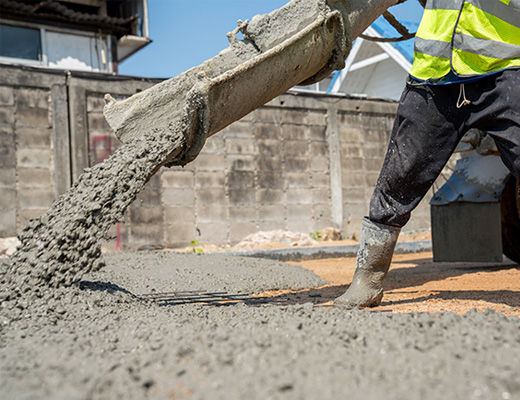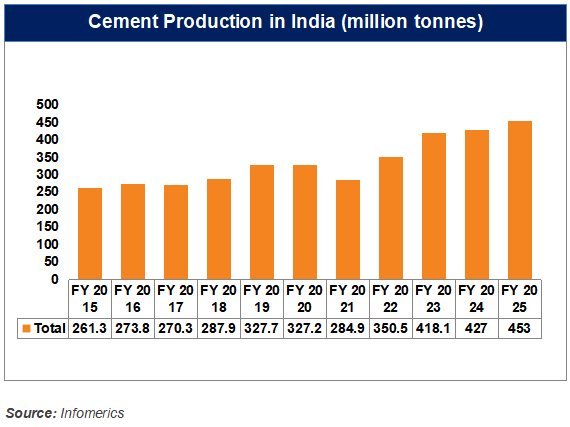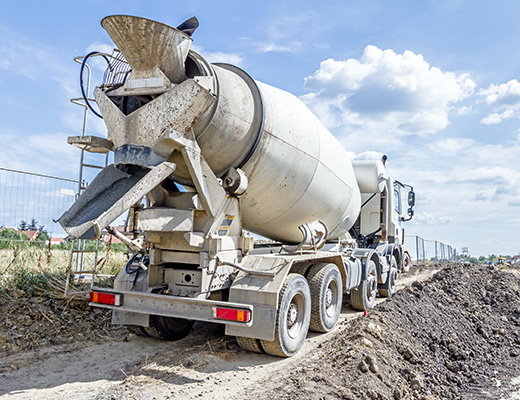Advantage India
Robust
Demand
*India's cement demand is expected to sustain its growth momentum with a projected increase of 7-8% in FY26. This robust growth is driven primarily by government housing initiatives like the Pradhan Mantri Awas Yojana (PMAY) and ongoing infrastructure development projects. Supported by a revival in construction activity and increased government capital expenditure, the real estate sector's expansion will continue to fuel strong cement demand.
*In FY25, India’s cement production rose to about 453 million tonnes, up from 426.29 million tonnes in FY24, registering a 6.3% YoY growth.
*India's cement industry, as per CRISIL Ratings, plans to increase its capacity by 150-160 MT between FY25 and FY28, building upon the 119 MT annual capacity addition over the last five years, to cater to growing infrastructure and housing demands.
*The GST revamp announced in September 2025 is expected to reduce cement prices by Rs. 30-35 (US$ 0.34-0.40) per 50-kg bag, lowering construction costs and potentially stimulating demand further in the sector.
Attractive
Opportunities
*As of August 2025, the Mumbai-Ahmedabad Bullet Train Corridor is significantly boosting the cement and construction industry, utilizing around 20,000 cubic meters of cement daily—equivalent to eight 10-story buildings. This project, spanning 508 km with multiple stations and tunnels, has generated substantial employment, with about 20,000 workers engaged daily.
*Government has plans for 33.4% outlays for capital investments to Rs. 10 lakh crore (US$ 120 billion) and outlays for railways of Rs. 2.4 lakh crore (US$ 29.05 billion). Also, plans to build 100 new significant transport projects involving an investment of Rs. 75,000 crore (US$ 9.04 billion) for end-to-end connectivity for ports, coal, steel etc.
*Karnataka approved investment proposals worth Rs. 17,183 crore (US$ 2.01 billion) in cement manufacturing, which are expected to generate around 12,500 jobs.
Long-term
Potential
*Indian cement companies are among the world’s greenest cement manufacturers.
*India's top four cement companies - UltraTech, ACC-Ambuja, Shree Cement, and Dalmia Cement are set to add over 42 million tonnes of capacity in FY25, increasing their market share from 48% in FY23 to an expected 54% by FY26.
*Indian cement makers plan to invest around Rs. 1.25 lakh crore (US$ 14.63 billion) between FY25 and FY27 to add 130 million tonnes of grinding capacity about 20% more than current levels.
*The government's infrastructure push is a significant catalyst, with projects like the Mumbai-Ahmedabad Bullet Train Corridor significantly boosting cement demand. This project alone uses around 20,000 cubic meters of cement daily, generating large-scale employment.
Increasing
Investments
*FDI inflows in the industry, related to the manufacturing of cement and gypsum products, reached Rs. 51,135 crore (US$ 7.92 billion) between April 2000-June 2025.
*National Infrastructure Pipeline (NIP) introduced projects worth Rs. 102 lakh crore (US$ 14.59 billion) for the next five years.
*As per the Union Budget 2025-26, the government approved an outlay of Rs. 2,87,333 crore (US$ 33.08 billion) for the Ministry of Road Transport and Highways i.e., 3% higher as compared to the previous budget.
*Shree Cement announces Rs 7,000 crore (US$ 844 million) investment for 12 million tonnes capacity expansion in India.
Cement Clusters
- Rajasthan
- Tamil Nadu
- Andhra Pradesh
- Madhya Pradesh
- Chhattisgarh
- Odisha

IBEF Campaigns
MORE
Aatmanirbhar Bharat Utsav 2024
Union Minister of External Affairs, Dr. S. Jaishankar and Union Commerce an...
Case Studies
MOREIBEF BLOG
MORERevival of India’s Forgotten Superfoods: Jackfruit, Amaranth and Moringa in Global Diets
For centuries, Indian kitchens have been home to an incredible diversity of...
Next-Gen GST: Powering India’s Investment and Demand Surge
India’s recent Goods and Services Tax (GST) overhaul is more than a s...
Transforming Spaces: The Growth and Opportunities in India’s Home Décor Industry
India’s home décor industry is evolving into one of the most d...














